
Guests
- Betsey Meansactress who retraces the steps of Mother Jones’s historic 1903 march from Philadelphia to the Long Island home of President Teddy Roosevelt.
Actress Betsey Means retraces the steps of Mother Jones’s historic 1903 march from Philadelphia to the Long Island home of President Teddy Roosevelt. The 70-year-old labor organizer was protesting the plight of child laborers. Means performs as Mother Jones in the Democracy Now! studios.
One hundred years ago this summer, labor organizer Mother Jones marched to the summer home of President Teddy Roosevelt on Long Island. By her side were three young mill workers. She was protesting the plight of child laborers.
Mother Jones’s march began in early July three weeks earlier in Philadelphia, where she had witnessed 10,000 children working in textile mills for close to no pay.
Well, last month, actress Betsey Means chose to commemorate the March of the Mill Children by retracing the steps of Mother Jones. For three weeks in July, she marched, often dressed as Mother Jones, from Philadelphia heading toward Long Island.
Today she arrives at Sagamore Hill in Oyster Bay. She will be performing as Mother Jones in the town, but not at Roosevelt’s former residence. Officials at the home, which is now a museum, brushed Means off very much like Mother Jones was brushed off 100 years ago.
When Mother Jones arrived on July 28, 1903, the president’s secretary told her the president was “unavailable.” One hundred years later, officials at the museum rejected Means’s offer to perform. A museum spokesperson recently told Newsday, “This is one of those minor footnotes of history.”
But neither the march nor the life of Mother Jones can be considered a footnote in American history.
The march brought Mother Jones national attention. Within three years, Pennsylvania, New Jersey and New York passed the nation’s first child labor laws.
At the time of the march, Mother Jones was about 70 years old.
Born in Cork, Ireland, the first 50 years of her life were unremarkable except for the fact that she faced tremendous hardship. Her husband and four children all died of yellow fever in 1867. Four years later, the Chicago Fire of 1871 destroyed her home and store.
It was not until she was about 50 years old when she became a full-time union organizer. She would continue to organize and raise hell until her death in 1930 at the age of 100.
Transcript
AMY GOODMAN: A hundred years ago this summer, labor organizer Mother Jones marched to the summer home of President Teddy Roosevelt on Long Island. By her side were young mill workers. She was protesting the plight of child laborers. Mother Jones’s march began in early July three weeks earlier in Philadelphia, where she had witnessed 10,000 children working in textile mills for close to no pay. At first, as she tried to come into New York City, the New York police commissioner said she would not be allowed, but relented because of popular outcry.
Well, last month, actress Betsey Means chose to commemorate the March of the Mill Children by retracing the steps of Mother Jones. For three weeks this past July, she marched, often dressed as Mother Jones, from Philadelphia to New York to Long Island. When officials heard that she wanted to perform — this was Betsey Means as Mother Jones — the Mother Jones address at Roosevelt’s summer home in Sagamore Hill, a museum official said, “This is one of those minor footnotes of history,” and said she would not be allowed to perform the address at Sagamore Hill, which is now a museum.
But neither the march nor the life of Mother Jones can be considered a footnote in American history. The march brought Mother Jones national attention. Within three years, Pennsylvania, New Jersey and New York passed the first child labor laws in the country.
At the time of the march, Mother Jones was about 70 years old. Born in Cork, Ireland, the first 50 years of her life were unremarkable except for the fact that she faced tremendous hardship. Her husband and four children all died of yellow fever in 1867. Four years later, the Chicago Fire of 1871 destroyed her home and store. It was not until she was about 50 years old when she became a full-time union organizer. She would continue to organize and raise hell until her death in 1930 at the age of 100.
Well, this summer, Betsey Means joined us in Democracy Now!’s studio as Mother Jones.
BETSEY MEANS: [as Mother Jones] When I look into the faces of the helpless children and see their appealing eyes, it touches the tender chords of a mother’s heart. I stand before you today on behalf of the helpless children. Organized labor and humanity demand protection for these helpless victims of insatiable greed. I have seen your children murdered. Murdered! You are living in America — America — where Patrick Henry and Jefferson lived, those heroes of days gone by. The day of child slavery has got to end.
On May 29th of this year, in the spring of this year, in Kensington, Pennsylvania, 75,000 textile workers went on strike. Of this number, at least 10,000 were little children. They’re striking for shorter hours. They wanted their work week reduced from 60 hours a week to 55 hours a week. Every day at union headquarters, little children came in, some with their hands off, some with a thumb missing, some with their fingers off at the knuckles. They’re stooped little things, round-shouldered and skinny. Many of them were not over 10 years of age, although the law prohibits their working before they are 12 years of age. Well, the law is poorly enforced. And the mothers of these children often swear falsely as to the ages of their children. In a single block in Kensington, 14 women, the mothers of 21 children, said it was a question of starvation or perjury, that the fathers had been killed or maimed at the mines.
I asked the newspaper reporters, “Why didn’t you report the facts about child labor in Pennsylvania?” “Ah, they said they couldn’t, because the mill owners had stock in the papers.” “Ah, is that a fact? But I have stock in these children,” I said. And I arranged for a little publicity.
We assembled a number of girls and boys one morning in Independence Park. Then, from there, we arranged to parade with banners to the courthouse, where I held a great meeting. A great crowd had gathered in the public square in front of City Hall. I put the little boys with their hands off and their fingers crushed and maimed up on the platform beside me, and I held up their mutilated hands, and I showed them to the crowd.
“Philadelphia’s mansions are built on the broken bones and quivering hearts of these children. Their little lives go out to make wealth for others. Neither state nor city officials pay any attention to these wrongs. They do not care that these children are to be the future citizens of our nation.”
Ah, the city officials were standing in the open windows opposite. I held up the little ones of the mill, high above the heads of the crowd, and pointed to their puny arms and legs and hollow chests. They were light to lift. “I call upon your millionaire manufacturers to cease your moral murders!” And I cried to the city officials in the open windows opposite, “Some day the workers will take possession of your City Hall. And when we do, no child will be sacrificed on the altar of profit!” Ah, the officials, they quickly closed their windows, just as they had closed their eyes and hearts.
The Philadelphia papers and the New York papers quoted my statement about Philadelphia’s mansions being built on the broken bones and quivering hearts of children. The Philadelphia papers and the New York papers, they got into a squabble with each other over the question. Universities discussed it. Preachers began talking. Now, that was what I wanted: public attention on the subject of child labor.
Fellow toilers, we have gathered here today for a purpose. Every movement made in the history of civilization has an underlying purpose. You have reached the century in human civilization when the charge of human slavery must forever disappear. I arise to ask the American people: Am I my children’s keeper? If we could raise up humanity to obviate our strife, what a glorious world this would be. But constituted as it is, society inflicts many hardships on those least able to bear them. We must work for peace and goodwill to all mankind. Children yet unborn will rise and bless you. Take the children out of the mills and mines and sweatshops. Allow them to develop their bodies and minds and souls. These children are to be the future citizens of America. Ah, yes, pray for the dead, and fight like hell for the living! Thank you very much! Thank you!
AMY GOODMAN: Mother Jones. One hundred years ago this week, she led the March of the Mill Children from Philadelphia to right here in New York, ending up in Sagamore Hill at Teddy Roosevelt’s home in Oyster Bay, though he did not come out to greet them.
BETSEY MEANS: [as Mother Jones] Oh, that’s right. He didn’t.
AMY GOODMAN: Can you talk about why you have decided to play Mother Jones? Betsey Means is the actor who is here with us today.
BETSEY MEANS: Oh, well, I’ll have to break out of character for that now, won’t I? I’m going to take off my glasses as a tribute to Mother Jones, and I’ll use my regular accent, my Chicago accent.
Two years ago, I found Mother Jones, not just knowing the name of the magazine or that she was associated with labor, and I went back and did research on her. And on a very personal level, I had a deep, profound respect for the courage that she had. She saw tremendous suffering. I mean, how many of us just go, oh — you know, who wants to really, really look at that? I mean, there’s so much happening in the world today, and who really wants to take that into their heart and mind and soul? And Mother Jones was able to not only go down into the Georgian cotton mills, into the Southern cotton mills, go into these factories that were essentially run by children, look at these children running barefooted up and down the spindles, working day and night in the factory, from 6:00 in the evening 'til 6:00 in the morning for 10 cents a night, being just ground out for profit. It's very painful material. And I just respected her tremendously for having the courage to do that.
AMY GOODMAN: Can you talk about Mother Jones’ history?
BETSEY MEANS: Yes, Mother Jones, she was acquainted with grief, as other great teachers that we have known. And she was born in Cork, Ireland. Her grandfather was hanged by the British soldiers. Her father had to flee Ireland. Police came into her home when she was 5, tore down her chimney looking for her father. She saw tremendous suffering in Ireland of the working poor. She came over — her father had come over to the United States. She came over in Memphis, Tennessee, when she was an adult, in 1867. Her husband and four children, they were living in the Pinch-Gut section of Memphis, the poor section, obviously, the poor, the hungry section, the Pinch-Gut section. And a yellow fever epidemic swept through Memphis. And in one week, her husband and four children died of yellow fever. Her whole family died. And then she went up to Chicago, opened a dressmaking establishment. In 1871, the Great Chicago Fire burned down everything she had.
So then she started going into the burned-down churches and listening to these tremendous speakers from the Knights of Labor. The Knights of Labor had been formed just after the Civil War, after chattel slavery had ended, industrial slavery was beginning — or, not beginning, but really, really coming into its own as surges of immigrants came over from the Old World. And she got radicalized. She got educated. And at this point, she really felt that God had saved her for a purpose. And so she went — after that, she had no money. She wore the clothes on her back. She went wherever there was a fight. She did this march when she was 73 years old. She went to Colorado after that, was thrown in prison illegally in her seventies, had guns forced into her face by the Pinkerton boys.
AMY GOODMAN: And this was over mining.
BETSEY MEANS: This was over mining. Her main work — actually, I chose for my piece to focus on this March of the Mill Children. It was very concise. It was an hour long. But her real work was with the miners of the United States of America. And she went in, and she — these miners were down in the coal mines for 14 hours a day, dying like flies, uneducated, never seeing the — she describes gorgeously the color of the eyes of their children. I mean, they were just being, again, ground out and dying of horrible, you know, hideous diseases. And the mill owners — oh, in the speech, she talks about the mill owners were making 15 to 90% profit out of the mills, and the mine owners were making tremendous profits. So, it was really one of these things where greed had taken over. And they were just using these people as merchandise, as chattel, and just grinding them out. If they died, that was fine. There was always another little person to take the place of a child worker when they died.
AMY GOODMAN: She also supported Eugene V. Debs, right? As the American Railway Union.
BETSEY MEANS: Oh, she loved Eugene Debs, absolutely. In fact, when she was down in Atlanta, Georgia, she talked to the miners and railroad boys, and they were the ones that first told her about these little children working in the mills. And she said, you know, it sounded like a modern-day Siberia. She thought that they were overdrawing the picture much, as she put it. So she decided to go into the cotton mills. And the first thing she was asked by the man who ran the mills is, “Do you have children?” And she lied and said, “Yes, there’s six of us.” And he showed her a little shanty to live in. And then she went in, in Cottondale, Alabama. She went into the mills and saw the children. She was shocked. She was absolutely shocked that this was happening. And then she went over to Tuscaloosa, worked in a rope factory. She walked in, and again, it was run by child labor.
AMY GOODMAN: So, when did child labor laws get passed, in relation to Mother Jones?
BETSEY MEANS: That’s a great question. On this march, the March of the Mill Children, that she did from Philadelphia to the door of Oyster Bay, Long Island, in 1903, within three years, New York, Pennsylvania and New Jersey passed child labor laws, that were enforced — underlined 12 times — that no child went into the mills before they were 14 years of age. Federal child labor laws in the United States were not passed until 1938.
AMY GOODMAN: OK, so let’s talk about this March of the Mill Children, as she goes from Philadelphia — with how many kids?
BETSEY MEANS: She leaves Philadelphia with 300. I think once they hit the city line, they probably lose half of them. And she had asked the parents if she could have their children for a week or 10 days. Well, the march stretched over three weeks. She gets into Trenton, you know, great union town. You know, they support her. But eventually there’s an attrition rate. These children are very weak. They really can’t make the march, even though the conductor on the Interurban car gave them free rides for a lot of the way. I mean, basically, it was too hard on the children. So she really — it really dwindled down, so that by the time she marched in New York City, she probably had 30 people with her, men, women and children.
AMY GOODMAN: And what happened in New York?
BETSEY MEANS: Oh, in New York — she gets to Hoboken, and she sends a committee over to speak with the chief of police, Epstein, asking for permission to march up Fourth Avenue to Madison Square. Well, the chief of police, you know, forbids their entrance to the city. So, she’s going, “Ehhh.” She goes over and speaks to Mayor Seth Low. The mayor is most courteous, but he says he’ll have to support the police commissioner. So Mother Jones reminds the mayor that a piece of rotten royalty had come over not but last year, Prince Henry, from Germany, and —
AMY GOODMAN: You’re listening to a Democracy Now! special on Labor Day. We’re talking to Betsey Means, who has played Mother Jones in the March of the Mill Children, the reenactment 100 years later.
BETSEY MEANS: So, she said, “You know, these children are the citizens of our nation; they create its wealth. They are not citizens, they don’t create its wealth.” So, finally, the mayor spoke to the chief of police, and they allowed the army in. They allowed the army in. They marched up Fourth Avenue accompanied, she says, by policemen, sergeants, roundsmen and reserves from three precincts. And eventually she holds the meeting in 20th Street where she shows them she really — the key thing was showing up with living children, the horrors of child labor. And once she did that to the citizenry, once they got out of these little pockets of mill towns — well, really, people didn’t know what was going on. And she showed them. The people rallied. The people rallied.
AMY GOODMAN: And so, she went from New York to the home of Teddy Roosevelt?
BETSEY MEANS: New York. She went to Coney Island, after she had received a letter from — she says the president; it was from B.F. Barnes, the acting secretary for the president — saying that, you know, the president has the heartiest sympathy with every effort to prevent child labor, but, you know, it’s really the states’ issues.”
So, she continues to march on, and she gets to the door of Teddy Roosevelt’s house on July 28th. And B.F. Barnes, the acting secretary for the president, meets her and says, “The president needs his rest. He can’t be bothered by matters which can be settled by us. If we allowed everyone to see him, he would have no time for himself.” So, she’s like, “OK. You know, oh, yes, of course, of course. Well, you know, the president has to go over on safari to Africa. He needs his rest to do that, to go chase the monkeys.”
And in the speech — and everything I say is Mother Jones’s own words, which is Shakespearean, really. She uses — anytime Shakespeare writes a highly emotionalized passage, he uses a lot of repetition, alliteration, assonance, everything. And her speech is just rich with that. It’s a very, you know, wonderful verbal horse to ride. But, basically, she said, “If the revolutionary fathers could come back to Earth, you know, the first question they would ask is: What has become of national pride?” She said that, you know, Roosevelt had — Roosevelt, it’s pronounced — had promised everything to labor. “When we had our strike in Colorado,” she reminds the people she’s talking to, “he sent 200 guns to blow our brains out. I don’t forget. You do, but I don’t. Our women were kicked out like dogs at the point of the bayonet. That is America.”
She goes on to say that some women in this country get up with $5 worth of paint on their faces and have toothbrushes for their dogs and say, “Oh, that horrible old woman, that horrible Mother Jones.” So, she said, “I am horrible, I admit, and I want to be to you blood-sucking pirates.”
AMY GOODMAN: Finally, are you going to go to the home of Teddy Roosevelt?
BETSEY MEANS: I called Oyster Bay Historical Society. I called Oyster Bay Public Library. I called — I talked to Charles at Sagamore Hill. He’ll be hearing that, probably — maybe — no, he probably won’t, might not watch_Democracy Now!_ But anyway, they all said no. I mean, she rips Teddy Roosevelt to shreds. She is furious with him. I mean, this is just not some, you know, hobo off the street. She has gotten substantial press all the way from Philadelphia to Oyster Bay, The New York Times. You know, I mean, she’s been in Philadelphia Inquirer You know, she’s gotten gorgeous publicity. So this is not just anyone coming — coming forth.
AMY GOODMAN: Well, Newsday did a very interesting piece, and they called the Sagamore Hill site, and they spoke to the spokesperson, Charles Markis —
BETSEY MEANS: Yes, Charles.
AMY GOODMAN: — to ask why you wouldn’t be able to perform there on the centennial of Mother Jones’s March of the Mill Children. He said, “This is one of those minor footnotes of history.”
BETSEY MEANS: Child labor, child slavery, a minor footnote. It’s going on now. You know, what’s amazing about this, and what would have really been heroic about Oyster Bay, about Sagamore Hill really bringing Mother Jones in, is, first of all, they could have had a spokesperson there, somebody saying, you know, what Teddy Roosevelt did do, you know, what he did accomplish. He was involved with a lot of trust busting, a lot of environmental issues. But — and also it’s tragically current history. We’re going into the global economy. Thirty-three million jobs were just created in China. They have a horrible human rights abuse record. There’s child labor happening all over the world right now — and in the United States of America still.
AMY GOODMAN: Betsey Means as Mother Jones. That does it for the show. If you want to get a copy, 1-800-881-2359. Our website, democracynow.org. From all of us at Democracy Now!, Happy Labor Day.

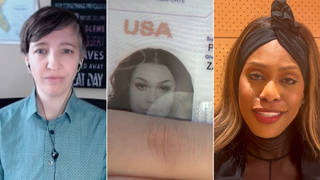
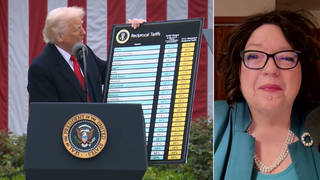
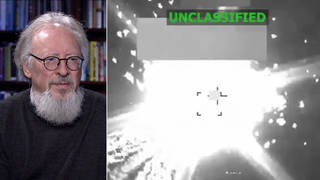
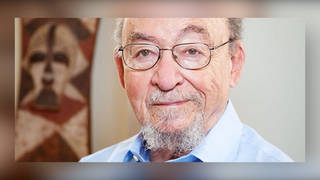





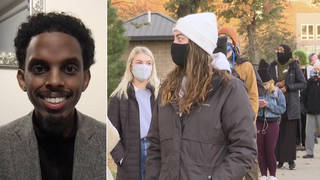
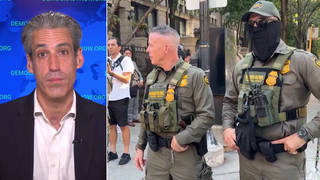
Media Options